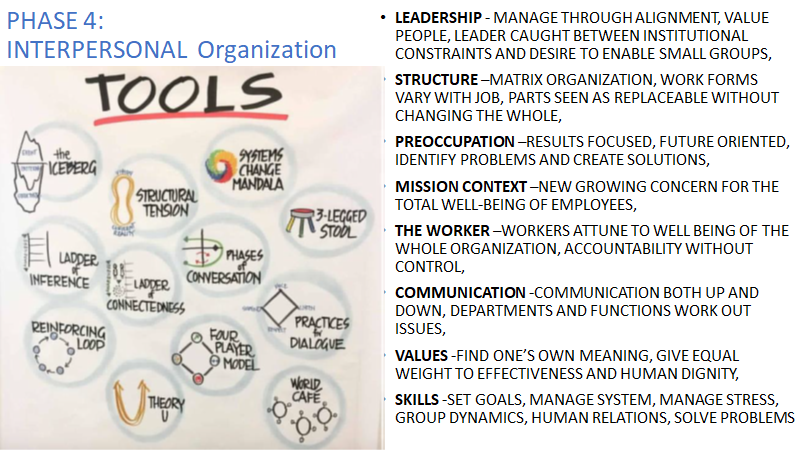(Organisational Journey Map Cont. 2)
More Information on Some Organisational Phases
- Hierarchical organisation (operates a style of benevolent paternalism, ie workers are treated like children in a family with a fatherly leader;
"...Orders and incentives come from the top down..."
The Canadian Institute of Cultural Affairs, 2012
Generally staff feedback is ignored in management decision-making; management likes to be in control and have labour submissive; skills required include problem-solving, administrative effectiveness and 'keeping calm'; reactive style of management, ie responding to problems and crises as they happen.
Some advantages of hierarchical organisations:
i) survivability (able to ride out the storms and survive)
ii) obvious structure of management and accountability.
Some disadvantages include:
i) failure to use intellectual capital
ii) failure to capitalise on creativity of staff
iii) setting priorities by crisis rather than vision
iv) minimal impact of staff on management's decision-making.
Summary
"...'hierarchical' refers to a style of top-down communication with staff/workers, participation is minimised, while the status and power of top management are maximised..."
The Canadian Institute of Cultural Affairs, 2012.)
- Institutional organisation (a large efficient bureaucratic structure with the following 'internal' stakeholders, ie board of directors, shareholders, CEO, senior management, middle management, supervisors and workers; style of management is responsiveness; recognise what business they are in and are strongly customer focused:
"...communications is from the top, but informed by feedback from below as well. The mode is task-oriented and output-focused. This is the kingdom of team, quality control and management by objectives..."
The Canadian Institute of Cultural Affairs, 2012
It works well in stable environments but struggles to handle a VUCA world.
Summary
Works well where there is
"...great order, great predictability, great loyalty to staff and to customers. The responsiveness to clients is rapid; responsiveness to social change is glacial. Attempts to change the organisation get bogged down in a morass of business as usual..."
The Canadian Institute of Cultural Affairs, 2012.)
NB Hierarchical and institutional organisations are
"...primarily concerned with the patterns of power relations, profit, efficient production and customer service......and structure..."
The Canadian Institute of Cultural Affairs, 2012
- Collaborative organisations (pivot around interaction, ie teamwork; usually have great structural flexibility with preference for a lattice organisation with all parts integrated to the whole, ie no part can be changed without altering the whole; focus on reducing rigidity and increasing flow of creativity, ie encourage free exchange of ideas and communications; less concerned about preventing unauthorised action; staff are self-actualising and seek to serve society through their work; focus on the people side of the organisation:
"...mission or goal is to make a quality impact on society......the leadership is enthusiastic, visionary, empathetic. The management style is facilitation. Key skills.....are delegating responsibility, managing group conflict, balancing work with leisure, growing from experience and helping others to do the same..."
The Canadian Institute of Cultural Affairs, 2012.
Some advantages of collaborative organisations:
i) great synergies and alignment within the organisation
ii) a mission related to social service
Some disadvantages of collaborative organisations:
i) internally focused, ie on the staff themselves, etc at the an expense of external focus, ie customers
ii) do not hold each other accountable.)
- Learning organisation (a network of self-directed teams that focus on interactive learning around people, ie human relations, and about 'making a difference', ie offer a vision of the future; redefined quality and learning, ie balancing the needs of a person, the group and the greater community; practise servant leadership, ie help others to maximise their performance; communication is empathetic; assume responsibility beyond job description to the whole organisation; involvement in community and personal growth encouraged; all encounters are regarded as learning situations; use of interpersonal and reflective skills to gain insights:
"...A core set of values is built or changed by consensus. A superb flexibility enables the organisation to deal with rapid change..."
The Canadian Institute of Cultural Affairs, 2012.)
Some disadvantages include:
- too much focus on networking
- with limited structure, consensus is more difficult to create
- accountability can slip
- quality work can falter.)
NB Collaborative and learning organisations are about
"...maximising vision, creativity, interaction, communications and collaboration...... are more about process, though structure remains important..."
The Canadian Institute of Cultural Affairs, 2012
- Interpersonal organisation

(source: Pauline Melnyk, 2023)
